Unit Commitment Towards Decarbonized Network Facing Fixed and Stochastic Resources Applying Water Cycle Optimization
Abstract
:1. Introduction
- Unit commitment importance and aim of the study;
- The reasons for selecting the objective function governing the unit commitment study, emission cost reduction;
- The advantages and disadvantages of integrating RERs into the study goals;
- The integration of PEVs and their advantages and disadvantages for achieving the quality of the goals
- A state of art in the unit commitment area and the optimization technique applied;
- The contribution and the structure of the paper
- They are quiet due to reducing the tailpipe emissions and air pollutants produced by gasoline or diesel-powered engines which harm the heart and lung health for the people living near roads;
- They require less maintenance;
- Recharging is cheaper than refueling with petrol which is a depleted energy resource, leading to less reliance on fossil fuels if powered by renewable energy;
2. Unit Commitment Formulation
- If PEVs are operated as an energy resource or a small power plant:
- If PEVs are added to the demand as loads:where; is the output power of each thermal unit “i” at each hour. is the power of each vehicle j, is plug in vehicle system efficiency. is number of vehicles that are connected to the network at this hour. N is number of units that are on in the unit commitment problem at each hour. & are the present and the departure state of charge (SOC) respectively.
2.1. Unit Commitment Solution Using Dynamic Programming Technique
2.2. Step by Step Tracking for Dynamic Programming
- (a)
- A state is composed of an arrangement of generating units with only accurate units in service, operating at a time while the remaining units are off-line.
- (b)
- The start-up cost of each unit is fixed and independent of the time, whether or not the generating unit is in off state.
- (c)
- No cost is involved for the shutdown of the unit.
- (d)
- At each interval, the order of priority is firm and a small amount of power should be in operation.
3. The Water Cycle Optimization Algorithm (WCOA)
3.1. Hydrologic Cycle
- Evaporation process: Because of high temperatures, water in lakes and rivers evaporate.
- Transpiration process: During photosynthesis, plants transpire and give off water.
- Condensation process: The water evaporated from rivers and the water transpired by trees generate clouds when such water is condensed into the colder atmosphere.
- Precipitation process: The water is released back to the earth in the form of rain
- Percolation process: When rain falls and glaciers melt, the water is reserved beneath the ground. The groundwater, aquifer, flows downward in the same way water flows on the ground surface completing the hydrologic cycle [37].
3.2. The Proposed WCOA
3.3. Step by Step Tracking and the Water Cycle Optimization Algorithm Flowchart
- Step 1: initialize the parameters of WCOA: Nsr, dmax, Npop, max_iteration.
- Step 2: create a random generation of initial population and generate the initial raindrops, rivers and sea by using Equations (12), (14) and (15).
- Step 3: determine the cost of each stream (raindrops) by using Equation (13).
- Step 4: evaluate the intensity of flow for rivers and sea by using Equation (16).
- Step 5: evaluate the flow of streams into the rivers by using Equation (18).
- Step 6: evaluate the flow of rivers into the sea which has the most downhill place by using Equation (19).
- Step 7: replace the positions of river and stream which achieves the best solution as described in Figure 4.
- Step 8: the same as in step 7, replace the position of river with the sea which achieves the best solution. The river may provide a better solution than the sea as described in Figure 4.
- Step 9: review the evaporation condition which can be obtained from the pseudo code.
- Step 10: after the evaporation condition is attained, the precipitation process will start by using Equations (21) and (22).
- Step 11: decrease dmax by using Equation (20).
- Step 12: if the termination criteria are satisfied, the algorithm will be ended. Otherwise, return back to step 5.
4. System Data under Study and Discussion
5. Simulation Results
5.1. Case 1 (Base Case)
5.2. Case 2 (PEVs and Three Thermal Units)
5.3. Case3 (RERs, and Three Thermal Units)
5.4. Case 4 (RERs, PEVs, and the Three Thermal Units)
6. Discussion
- The total cost and emissions for the base 3-generator units increase when integrating PEVs with the base 3 thermal units, and exceed the emission limit more than the base case.
- Integrating RERs, both wind and solar energy to partially replace thermal (coal-fired) generation units contributes to reducting both the fuel cost and the emissions. Significant reduction in emission occurs when integrating only RERs with the base three thermal units. However, the uncertainty of wind and solar energy is based on several factors such as geographical area, the forecasting models used and period-ahead forecasting. These variables affect the uncertainty percentage and the overall accuracy.
- Integrating both RERs and PEVs into the smart grid showed a significant decrease in fuel cost, emissions and total cost. RERs is accumulated to reduce emissions from both conventional units and PEVs. PEVs is integrated to solve the uncertainty behavior of RERs.
- The results extracted from the proposed algorithm (WCOA) proved its efficiency with respect to the results of both dynamic programing (DP) and genetic algorithm (GA).
7. Conclusions
- (i)
- Reduction in total cost including the emission cost.
- (ii)
- Decarbonizing the emissions from the conventional generators and the transportation sector.
- (iii)
- Presenting new types of storage energy in the electricity sector by replacing conventional vehicles with electrical vehicles with environment-friendly batteries and encouraging the consumers to supply electrical power to the grid during the on-peak periods.
- (1)
- The base 3-thermal (coal-fired) units.
- (2)
- PEVs (V2G/G2V) with the conventional units.
- (3)
- RERs (wind/Solar) with the conventional units.
- (4)
- Integrating PEVs (V2G/G2V), RERs (wind/solar) with the conventional units.
- (1)
- Water cycle optimization algorithm (WCOA).
- (2)
- Genetic algorithm (GA).
- (3)
- Dynamic programing (DP).
- (i)
- Increasing the reliability and stability of the electricity grid.
- (ii)
- Decarbonizing the emissions from the electricity sector and transportation sector.
- (iii)
- Introducing new types of unit commitment sourses with different distributions, for environment-friendly electrical energy storage such as PEVs (V2G) to encourage the consumers to supply electrical power to the grid during the on-peak periods of the electrical network operation.
Author Contributions
Conflicts of Interest
Nomenclature
| the output power of each thermal unit “i” at each hour | |
| A, B, C | the coefficients of a quadratic fuel cost function of each thermal generating unit |
| NG | the number of conventional thermal units |
| the output power from a wind plant at each hour | |
| the output power from a solar plant at each hour | |
| α | CO2 emission factor |
| the emission penalty factor | |
| the power of each vehicle j | |
| the system efficiency | |
| number of vehicles that are connected to the network at this hour | |
| the total vehicles in the network | |
| N | number of units that are on in the unit commitment problem at each hour |
| the present state of charge (SOC) | |
| the departure state of charge (SOC) | |
| the depletion of storage energy at minimum level | |
| the charging up to maximum level | |
| on/off state of each unit “i” | |
| X | the number of states to search each period in DP algorithm |
| N | the number of strategies to save at each step in DP algorithm |
| 2N − 1 | maximum value of X or N in DP algorithm |
| Nvar | a dimensional optimization problem or number of design variables in the WCO algorithm |
| Raindrop | a single solution in an array of 1 × Nvar in the WCO algorithm |
| (X1, X2, X3, …, XNar) | the decision variable values in WCO algorithm |
| NSn | the number of streams that travel towards certain rivers or the sea in the WCO algorithm |
| Npop | the number of population in the WCO algorithm |
| Nsr | the summation of the number of rivers in the WCO algorithm |
| X | the distance between the stream and the river in the WCO algorithm |
| LB and UB | lower and upper boundaries of the designed problem in the WCO algorithm |
| dmax | a small number and its value is near to zero in the WCO algorithm |
| µ | a coefficient to get the range of searching area close to the sea in the WCO algorithm |
References
- Lopez, C.J.; Ano, O.; Esteybar, D.O. Stochastic Unit Commitment & Optimal Allocation of Reserves: A Hybrid Decomposition Approach. IEEE Trans. Power Syst. 2018. [Google Scholar] [CrossRef]
- Krishnamurthy, S.; Tzoneva, R. Comparative analyses of Min-Max and Max-Max price penalty factor approaches for multi criteria power system dispatch problem with valve point effect loading using Lagrange’s method. In Proceedings of the 2011 IEEE International Conference on Power and Energy Systems (ICPS), Chennai, India, 22–24 December 2011. [Google Scholar] [CrossRef]
- Zhou, B.; Ai, X.; Fang, J.; Wen, J.; Yang, J. Mixed-integer second-order cone programming taking appropriate approximation for the unit commitment in hybrid AC–DC grid. In Proceedings of the IEEE 6th International Conference on Renewable Power Generation (RPG), Wuhan, China, 19–20 October 2017. [Google Scholar]
- Alejandre, L.M.C.; Alcaraz, G.G. Analysis of Security Constrained Unit Commitment using Three Models of Electricity Generation Cost Linearization. In Proceedings of the IEEE Conference on Texas Power and Energy Conference (TPEC), College Station, TX, USA, 8–9 February 2018. [Google Scholar] [CrossRef]
- Elsayed, A.M.; Maklad, A.M.; Farrag, S.M. A New Priority List Unit Commitment Method for Large-Scale Power Systems. In Proceedings of the 2017 Nineteenth International Middle East Power Systems Conference (MEPCON), Cairo, Egypt, 19–21 December 2017. [Google Scholar]
- Venayagamoorthy, G.K.; Braband, G. Carbon reduction potential with intelligent control of power systems. In Proceedings of the 17th World Congress: International Federation of Automatic Control, Seoul, Korea, 6–11 July 2008. [Google Scholar]
- Labatt, S.; White, R.R. Carbon Finance: The Financial Implications of Climate Change; Wiley: Hoboken, NJ, USA, 2007. [Google Scholar]
- Godina, R.; Rodrigues, E.M.G.; Pouresmaeil, E.; Catalão, J.P.S. Optimal residential model predictive control energy management performance with PV microgeneration. Comput. Oper. Res. 2017, in press. [Google Scholar]
- Rodrigues, E.M.G.; Godina, R.; Pouresmaeil, E.; Ferreira, J.R.; Catalão, J.P.S. Domestic appliances energy optimization with model predictive control. Energy Convers. Manag. 2017, 142, 402–413. [Google Scholar] [CrossRef]
- Oliveira, D.; Rodrigues, E.M.G.; Godina, R.; Mendes, T.D.P.; Catalão, J.P.S.; Pouresmaeil, E. Enhancing Home Appliances Energy Optimization with Solar Power Integration. In Proceedings of the IEEE International Conference on Computer as a Tool (EUROCON 2015), Salamanca, Spain, 8–11 September 2015. [Google Scholar] [CrossRef]
- Godina, R.; Rodrigues, E.M.G.; Pouresmaei, E.; Matias, J.C.O.; Catalão, J.P.S. Model Predictive Control Home Energy Management and Optimization Strategy with Demand Response. Appl. Sci. 2018, 8, 408. [Google Scholar] [CrossRef]
- Silva, J.M.; Rodrigues, E.; Godina, R.; Catalao, J.P.S. Residential MPC controller performance in a household with PV microgeneration. In Proceedings of the 2017 IEEE Conference on Manchester PowerTech, Manchester, UK, 18–22 June 2017. [Google Scholar] [CrossRef]
- Nguyen, D.T.; Le, L.B. Risk-constrained profit maximization for microgrid aggregators with demand response. IEEE Trans. Smart Grid 2015, 6, 135–146. [Google Scholar] [CrossRef]
- Stock, A.; Stock, P.; Sahajwalla, V. Powerful Potential: Battery Storage for Renewable Energy and Electric Cars; Climate Council of Australia Ltd.: Sydney, Australia, 2015; ISBN 978-0-9944195-4-5 (print), 978-0-9944195-3-8 (web). [Google Scholar]
- Nieto, A.; Vita, V.; Maris, T.I. Power quality improvement in power grids with the integration of energy storage systems. Int. J. Eng. Res. Technol. (IJERT) 2016, 5, 438–443. [Google Scholar]
- Nykvist, B.; Nilsson, M. Rapidly falling costs of battery packs for electric vehicles. Nat. Clim. Chang. 2015, 5, 329–332. Available online: http://www.nature.com/nclimate/journal/v5/n4/full/nclimate2564.html (accessed on 12 March 2018). [CrossRef]
- King Island Advanced Hybrid Power Station. Available online: www.kingislandrenewableenergy.com.au/history/king-island-renewable-energy (accessed on 13 March 2018).
- Al Ghaithi, H.M.; Fotis, G.P.; Vita, V. Techno-economic assessment of hybrid energy off-grid system—A case study for Masirah island in Oman. Int. J. Power Energy Res. 2017, 1, 103–116. [Google Scholar] [CrossRef]
- Agamah, S.U.; Ekonomou, L. Energy storage system scheduling for peak demand reduction using evolutionary combinatorial optimization. Sustain. Energy Technol. Assess. 2017, 23, 73–82. [Google Scholar]
- Agamah, S.; Ekonomou, L. A heuristic combinatorial optimization algorithm for load-leveling and peak demand reduction using energy storage systems. Electr. Power Compon. Syst. 2018, 45, 2093–2103. [Google Scholar] [CrossRef]
- Center for Climate and Energy Solution. Climate Solution, Technology Solution, Electrical Vehicles. Available online: www.c2es.org/content/electric-vehicles/ (accessed on 3 March 2018).
- Little, A.D.; Browning, L.; Santini, D.; Vyas, A.; Taylor, D.; Markel, T.; Duvall, M.; Graham, R.; Miller, A.; Frank, A.; et al. Comparing the Benefits and Impacts of Hybrid Electric Vehicle Options; for Compact Sedan and Sport Utility Vehicles; Electric Power Research Institute (EPRI): Palo Alto, CA, USA, 2002; p. 1006892. Available online: http://www.evworld.com/library/EPRI_sedan_options.pdf (accessed on 13 March 2018).
- Corrigan, D.; Masias, A. Batteries for Electric and Hybrid Vehicles. In Linden’s Handbook of Batteries, 4th ed.; Reddy, T.B., Ed.; McGraw Hill: New York, NY, USA, 2011. [Google Scholar]
- Vita, V. Development of a decision-making algorithm for the optimum size and placement of distributed generation units in distribution networks. Energies 2017, 10, 1433. [Google Scholar] [CrossRef]
- Boulanger, A.G.; Chu, A.C.; Maxx, S.; Waltz, D.L. Vehicle electrification: Status and issues. Proc. IEEE 2011, 99, 1116–1138. [Google Scholar] [CrossRef]
- Ghasemi, A.; Mortazavi, S.S.; Mashhour, E. Hourly demand response and battery energy storage for imbalance reduction of smart distribution company embedded with electric vehicles and wind farms. Renew. Energy 2016, 85, 124–136. [Google Scholar] [CrossRef]
- Morais, H.; Sousa, T.; Soares, J.; Faria, P.; Vale, Z. Distributed energy resources management using plug-in hybrid electric vehicles as a fuel-shifting demand response resource. Energy Convers. Manag. 2015, 97, 78–93. [Google Scholar] [CrossRef]
- Li, K.; Xue, Y.; Cui, S.; Niu, Q.; Yang, Z.; Luk, P. Advanced computational methods in energy, power, electric vehicles and their integration. In Proceedings of the International Conference on Life System Modeling and Simulation (LSMS2017) and International Conference on Intelligent Computing for Sustainable Energy and Environment (ICSEE 2017), Nanjing, China, 22–24 September 2017; Part III. Springer: Berlin, Germany, 1842. [Google Scholar]
- Wedyan, A.; Whalley, J.; Narayanan, A. Hydrological Cycle Algorithm for Continuous Optimization Problems. J. Glob. Optim. 2017, 37, 405–436. [Google Scholar] [CrossRef]
- Moradi, M.; Sadollah, A.; Eskandar, H.; Eskandarc, H. The application of water cycle algorithm to portfolio selection. J. Econ. Res. Ekon. Istraž. 2017, 30, 1277–1299. [Google Scholar]
- Yanjun, K.; Yadong, M.; Weinan, L.; Xianxun, W.; Yue, B. An enhanced water cycle algorithm for optimization of multi-reservoir systems. In Proceedings of the 2017 IEEE/ACIS 16th International Conference on Computer and Information Science (ICIS), Wuhan, China, 24–26 May 2017. [Google Scholar]
- Eskandara, H.; Sadollahb, H.; Bahreininejadb, A. Weight Optimization of Truss Structures Using Water Cycle Algorithm. Int. J. Optim. Civ. Eng. 2013, 3, 115–129. [Google Scholar]
- Sadollah, A.; Eskandar, H.; Kim, J. Water cycle algorithm for solving constrained multi-objective optimization problems. Appl. Soft Comput. 2015, 27, 279–298. [Google Scholar] [CrossRef]
- World Bank and Ecofys. Carbon Pricing Watch 2017. 2017. Available online: https://openknowledge.worldbank.org/handle/10986/26565, (accessed on 3 March 2018).
- Tung, N.S.; Bhadoria, A.; Kaur, K.; Bhadauria, S. Dynamic programming model based on cost minimization algorithms for thermal generating units. Int. J. Enhanc. Res. Sci. Technol. Eng. 2012, 1, 19–27. [Google Scholar]
- Thakur, N.; Titare, L.S. Determination of unit commitment problem using dynamic programming. Int. J. Nov. Res. Electr. Mech. Eng. 2016, 3, 24–28. [Google Scholar]
- Shi, J.; Dong, X.; Zhao, T.; Du, Y.; Liu, H.; Wang, Z.; Zhu, D.; Xiong, C.; Jiang, L.; Shi, J.; et al. The Water Cycle Observation Mission (WCOM): Overview. In Proceedings of the IEEE International Geoscience and Remote Sensing Symposium (IGARSS), Beijing, China, 10–15 July 2016. [Google Scholar]
- Bozorg-Haddad, O.; Solgi, M.; Loáiciga, H.A. Meta-Heuristic and Evolutionary Algorithms for Engineering Optimization, 1st ed.; John Wiley & Sons, Inc.: Hoboken, NJ, USA, 2017; pp. 231–240. [Google Scholar]
- Eskandar, H.; Sadollah, A.; Bahreininejad, A.; Hamdi, M. Water cycle algorithm—A novel metaheuristic optimization method for solving constrained engineering optimization problems. Comput. Struct. 2012, 110–111, 151–166. [Google Scholar] [CrossRef]
- He, D.; Tan, Z.; Harley, R.G. Chance constrained unit commitment with wind generation and superconducting magnetic energy storages. In Proceedings of the IEEE Power and Energy Society General Meeting, San Diego, CA, USA, 22–26 July 2012. [Google Scholar]
- Saber, A.Y.; Venayagamoorthy, G.K. Efficient utilization of renewable energy sources by gridable vehicles in cyber-physical energy systems. IEEE Syst. J. 2010, 4, 285–294. [Google Scholar] [CrossRef]
- International Renewable Energy Agency (IRENA). Renewable Power Generation Costs in 2017; International Renewable Energy Agency: Abu Dhabi, United Arab Emirates, 2018; Available online: http://www.irena.org/publications/2018/Jan/Renewable-power-generation-costs-in-2017 (accessed on 18 March 2018).
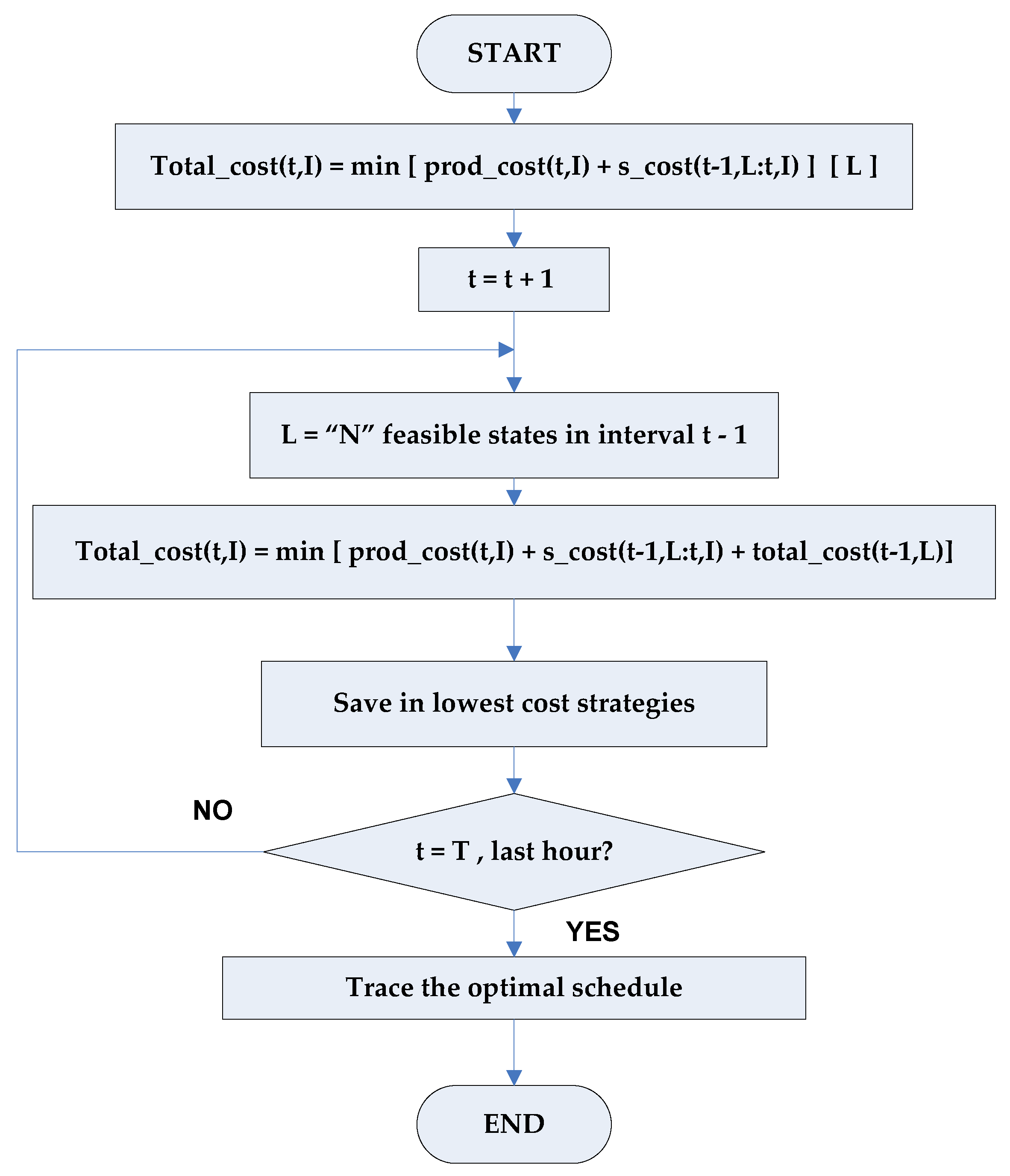
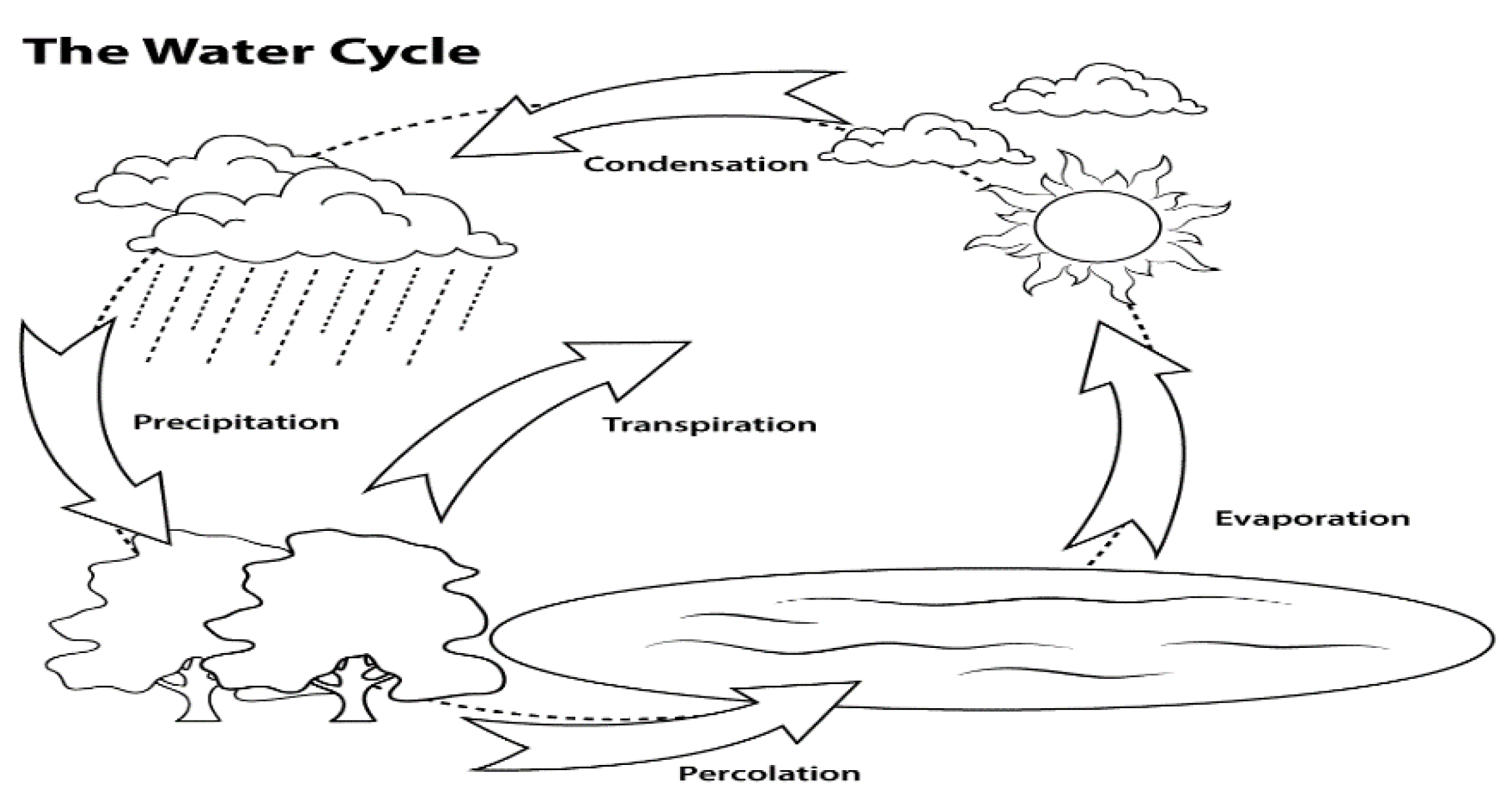
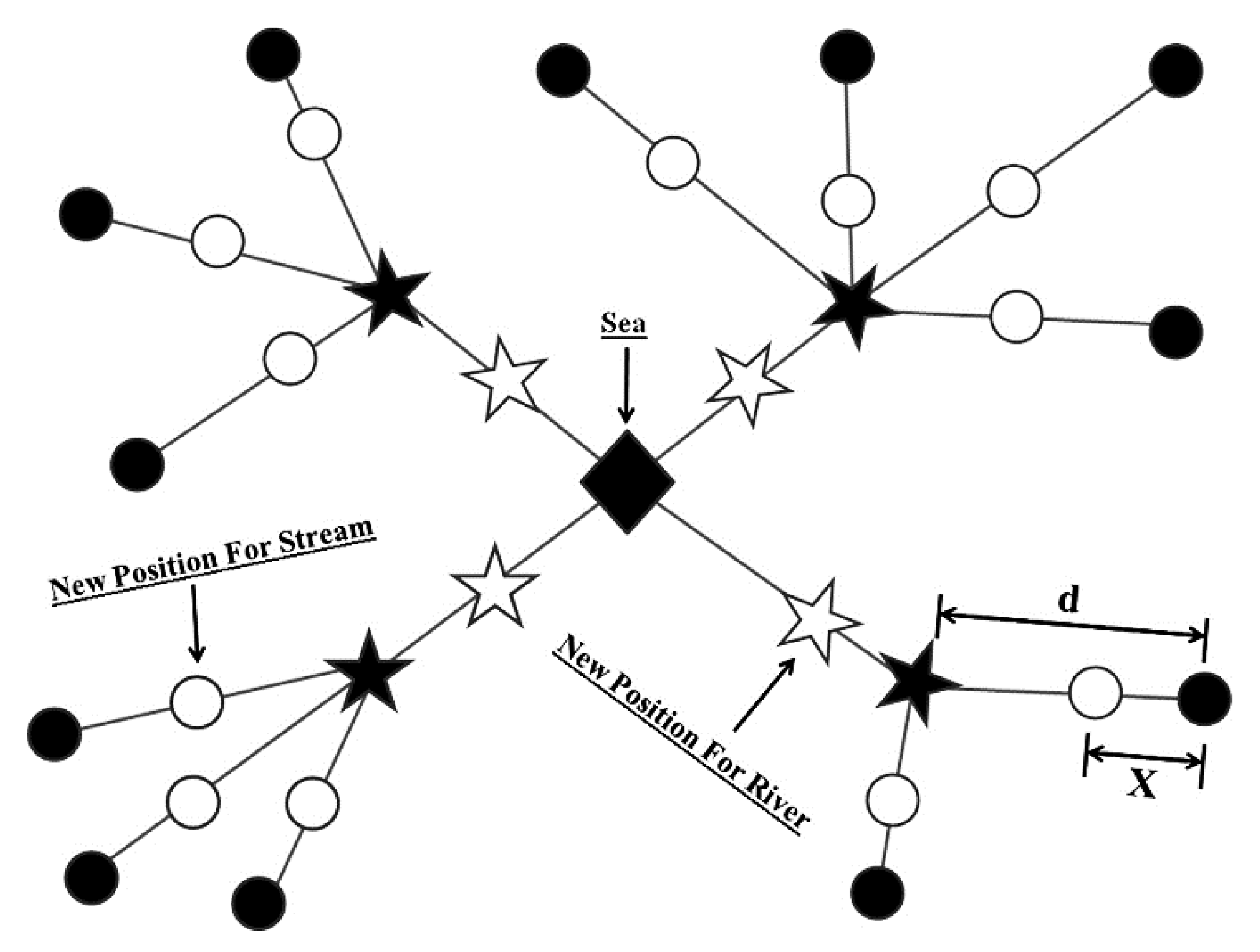
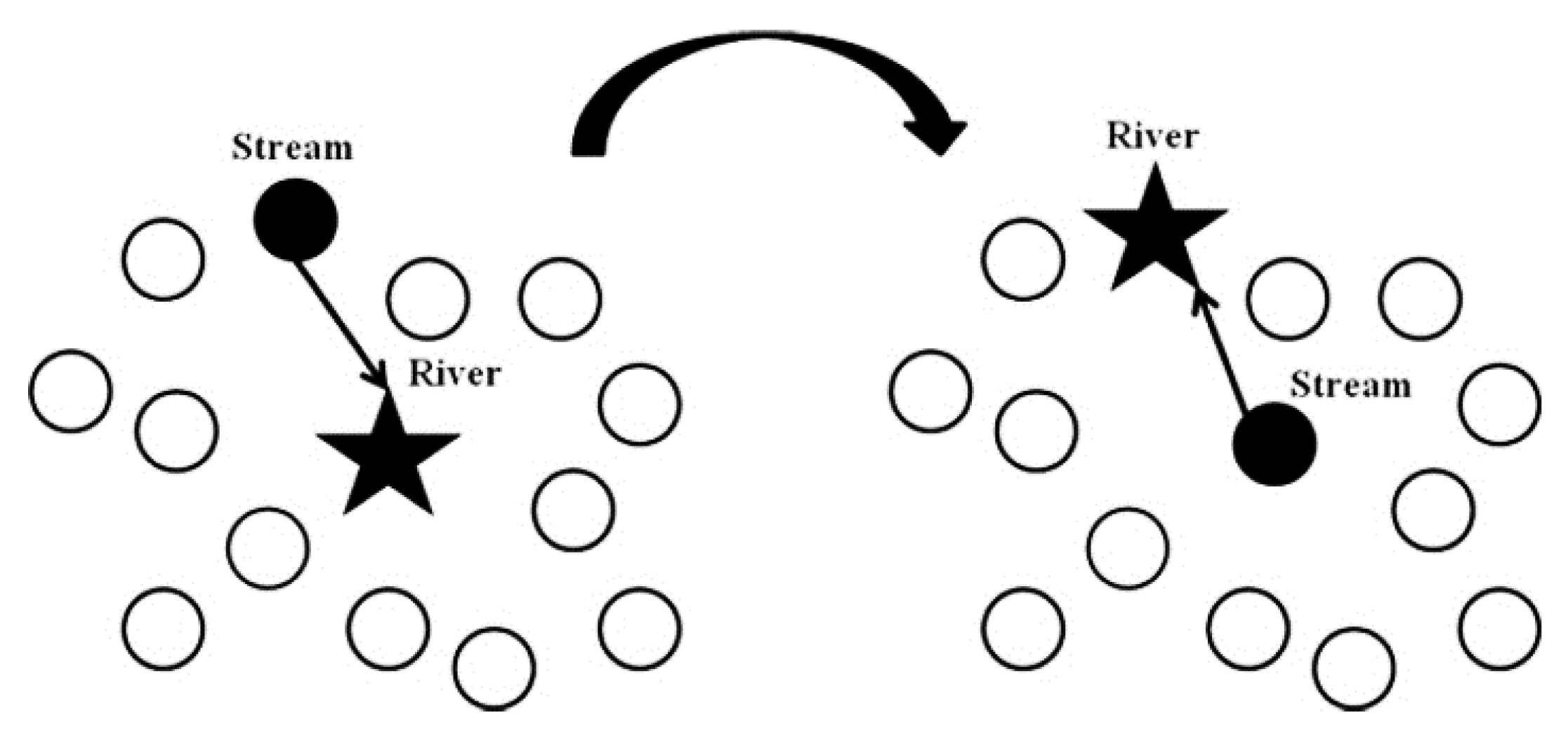
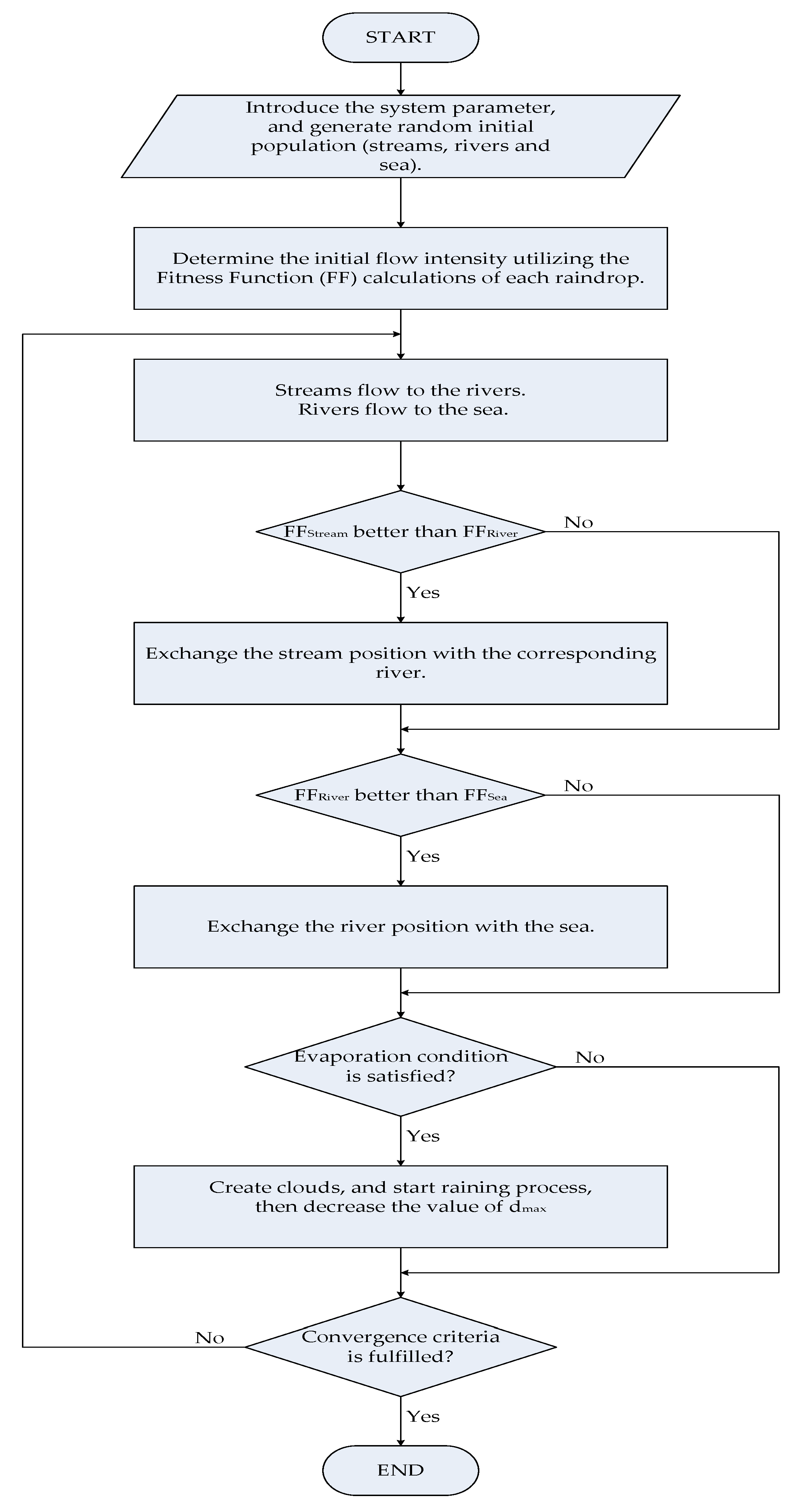

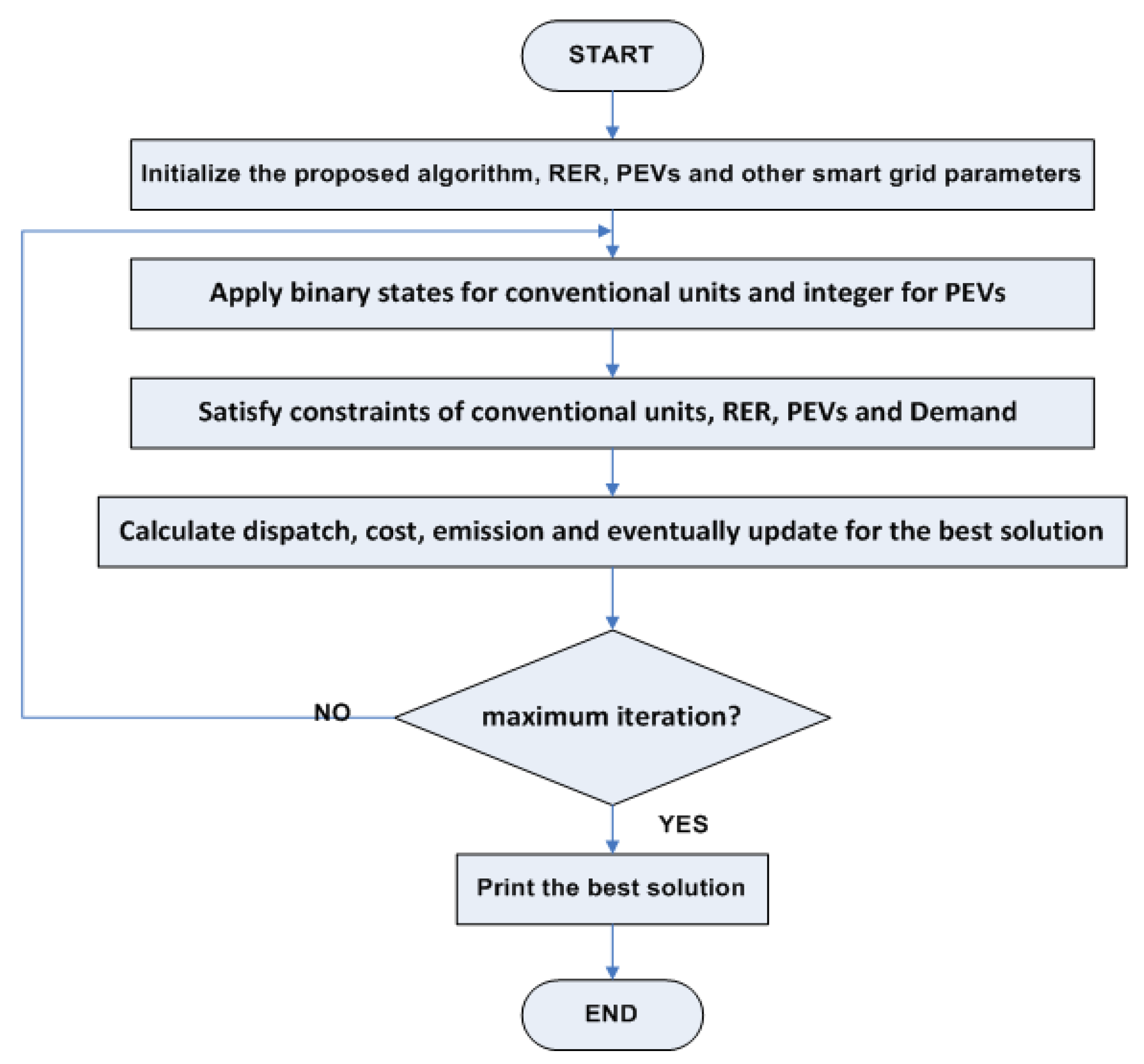
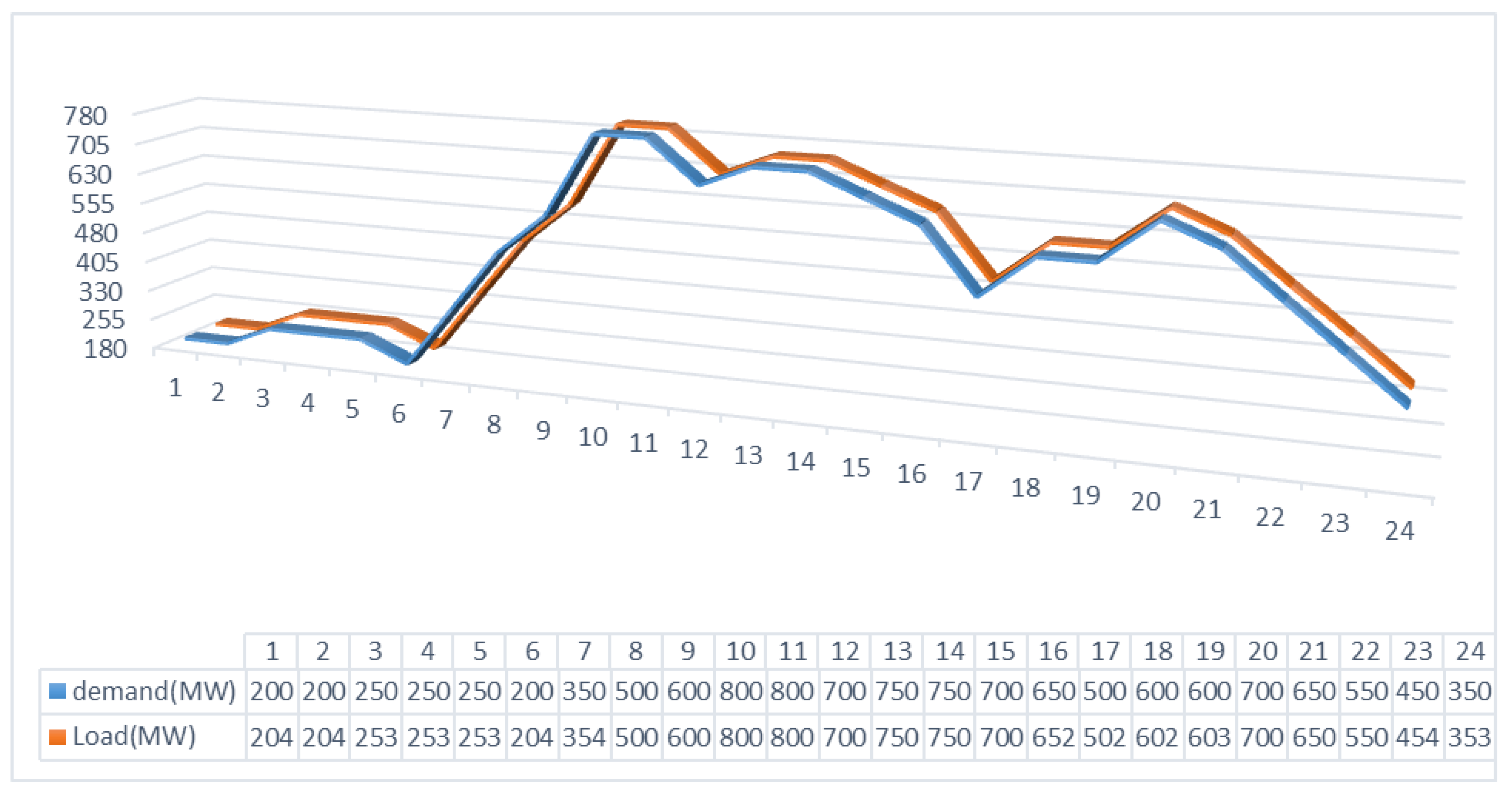
| Energy Resource | CO2 Emission Factor (Ton/kWh) |
|---|---|
| Wind | 21.0 × 10−6 |
| Hydro | 15.0 × 10−6 |
| Solar | 6.00 × 10−6 |
| Natural Gas | 5.99 × 10−4 |
| Fuel oil | 8.93 × 10−4 |
| Coal | 9.55 × 10−4 |
| Unit | Pmin (MW) | Pmax (MW) | Ramp up (MW/h) | Ramp down (MW/h) | Intial State at Time |
|---|---|---|---|---|---|
| G1 | 30 | 600 | 200 | 50 | On |
| G2 | 30 | 600 | 200 | 20 | Off |
| G3 | 20 | 400 | 200 | 50 | On |
| Unit | Fuel Consumption Function | Startup Cost ($) | Shut down Cost ($) | ||
|---|---|---|---|---|---|
| A (MBtu) | B (MBtu/MWh) | C (MBtu/MWh2) | |||
| G1 | 176.9 | 13.5 | 0.04 | 1200 | 800 |
| G2 | 129.9 | 40.6 | 0.001 | 1000 | 500 |
| G3 | 137.4 | 17.6 | 0.005 | 1500 | 800 |
| Hour | Wind (MW) | Solar (MW) | Hour | Wind (MW) | Solar (MW) | Hour | Wind (MW) | Solar (MW) | Hour | Wind (MW) | Solar (MW) |
|---|---|---|---|---|---|---|---|---|---|---|---|
| 1 | 8.2 | 0 | 7 | 4.6 | 5 | 13 | 59.0 | 65.0 | 19 | 72.2 | 0 |
| 2 | 11.4 | 0 | 8 | 49.3 | 22.04 | 14 | 78.1 | 58.27 | 20 | 73.3 | 0 |
| 3 | 66.9 | 0 | 9 | 45.6 | 53.95 | 15 | 44.9 | 53.79 | 21 | 65.3 | 0 |
| 4 | 69.8 | 0 | 10 | 10.1 | 67.4 | 16 | 19.5 | 47.06 | 22 | 24.5 | 0 |
| 5 | 55.4 | 0 | 11 | 24.8 | 67.32 | 17 | 3.7 | 27.11 | 23 | 49.9 | 0 |
| 6 | 50.9 | 0 | 12 | 37.3 | 69.64 | 18 | 16.5 | 11 | 24 | 40.3 | 0 |
| Time (Hour) | ThermUnit-1 (MW) | ThermUnit-2 (MW) | ThermUnit-3 (MW) | Emission (ton) | Demand (MW) | |||
|---|---|---|---|---|---|---|---|---|
| 1 | 67.735 | 0 | 132.265 | 191 | 200 | |||
| 2 | 67.778 | 0 | 132.222 | 191 | 200 | |||
| 3 | 73.334 | 0 | 176.666 | 238.75 | 250 | |||
| 4 | 73.333 | 0 | 176.667 | 238.75 | 250 | |||
| 5 | 73.332 | 0 | 176.668 | 238.75 | 250 | |||
| 6 | 67.633 | 0 | 132.367 | 191 | 200 | |||
| 7 | 84.444 | 0 | 265.556 | 334.25 | 350 | |||
| 8 | 101.109 | 0 | 398.891 | 477.5 | 500 | |||
| 9 | 92.734 | 158.375 | 348.891 | 573 | 600 | |||
| 10 | 97.089 | 329.012 | 373.899 | 764 | 800 | |||
| 11 | 96.688 | 339.075 | 364.237 | 764 | 800 | |||
| 12 | 66.688 | 319.075 | 314.237 | 668.5 | 700 | |||
| 13 | 95.658 | 299.075 | 355.267 | 716.25 | 750 | |||
| 14 | 95.126 | 296.051 | 358.823 | 716.25 | 750 | |||
| 15 | 92.654 | 276.051 | 331.295 | 668.5 | 700 | |||
| 16 | 89.327 | 256.051 | 304.622 | 620.75 | 650 | |||
| 17 | 101.11 | 0 | 398.89 | 477.5 | 500 | |||
| 18 | 92.677 | 158.433 | 348.89 | 573 | 600 | |||
| 19 | 93.117 | 173.822 | 333.061 | 573 | 600 | |||
| 20 | 95.146 | 254.079 | 350.775 | 668.5 | 700 | |||
| 21 | 91.782 | 234.08 | 324.138 | 620.75 | 650 | |||
| 22 | 150 | 0 | 400 | 525.25 | 550 | |||
| 23 | 100 | 0 | 350 | 429.75 | 450 | |||
| 24 | 50 | 0 | 300 | 334.25 | 350 | |||
| Start-up cost | Fuel cost | Total cost | Emissions | |||||
| 3000.000 $/day | 247,284.867 $/day | 368,227.367 $/day | 11,794.250 ton/day | |||||
| Time (Hour) | ThermUnit-1 (MW) | ThermUnit-2 (MW) | ThermUnit-3 (MW) | PEV Unit-4 (V2G/G2V) | Emission (Ton) | Demand (MW) | |||
|---|---|---|---|---|---|---|---|---|---|
| 1 | 68.173 | 0 | 135.381 | −3.554 | 194.394 | 203.554 | |||
| 2 | 68.174 | 0 | 135.342 | −3.516 | 194.358 | 203.516 | |||
| 3 | 73.677 | 0 | 179.391 | −3.068 | 241.68 | 253.068 | |||
| 4 | 73.659 | 0 | 179.554 | −3.213 | 241.818 | 253.213 | |||
| 5 | 73.531 | 0 | 179.481 | −3.012 | 241.626 | 253.012 | |||
| 6 | 68.852 | 0 | 135.454 | −3.624 | 194.461 | 203.624 | |||
| 7 | 84.852 | 0 | 268.82 | −3.672 | 337.757 | 353.672 | |||
| 8 | 100.221 | 0 | 391.791 | 7.988 | 477.005 | 500 | |||
| 9 | 192.733 | 0 | 400 | 7.268 | 572.549 | 600 | |||
| 10 | 339.856 | 44.207 | 400 | 15.938 | 763.012 | 800 | |||
| 11 | 339.777 | 41.098 | 400 | 19.125 | 762.814 | 800 | |||
| 12 | 289.777 | 30 | 364.285 | 15.938 | 667.512 | 700 | |||
| 13 | 311.075 | 30 | 400 | 8.925 | 715.697 | 750 | |||
| 14 | 306.945 | 30 | 400 | 13.055 | 715.441 | 750 | |||
| 15 | 264.993 | 30 | 400 | 5.007 | 668.19 | 700 | |||
| 16 | 222.242 | 30 | 400 | −2.242 | 622.891 | 652.242 | |||
| 17 | 0 | 102.363 | 400 | −2.363 | 479.756 | 502.363 | |||
| 18 | 120.136 | 82.363 | 400 | −2.499 | 575.386 | 602.499 | |||
| 19 | 202.808 | 0 | 400 | −2.808 | 575.681 | 602.808 | |||
| 20 | 291.596 | 0 | 400 | 8.404 | 667.979 | 700 | |||
| 21 | 241.596 | 0 | 396.849 | 11.555 | 620.034 | 650 | |||
| 22 | 191.596 | 0 | 351.682 | 6.721 | 524.833 | 550 | |||
| 23 | 141.596 | 0 | 312.563 | −4.159 | 433.722 | 454.159 | |||
| 24 | 0 | 0 | 353.322 | −3.322 | 337.422 | 353.322 | |||
| Start-up cost | Fuel cost | Total cost | Emissions | ||||||
| 4300.000 $/day | 269,843.179 $/day | 392,403.355 $/day | 11,826.018 ton/day | ||||||
| Time (Hour) | ThermUnit-1 (MW) | ThermUnit-2 (MW) | ThermUnit-3 (MW) | Wind (MW) | Solar (MW) | Emission (ton) | Demand (MW) | |||
|---|---|---|---|---|---|---|---|---|---|---|
| 1 | 66.867 | 0 | 124.933 | 8.2 | 0 | 183.341 | 200 | |||
| 2 | 66.511 | 0 | 122.089 | 11.4 | 0 | 180.352 | 200 | |||
| 3 | 65.901 | 0 | 117.119 | 66.9 | 0 | 176.265 | 250 | |||
| 4 | 65.578 | 0 | 114.622 | 69.8 | 0 | 173.557 | 250 | |||
| 5 | 67.178 | 0 | 127.422 | 55.4 | 0 | 187.006 | 250 | |||
| 6 | 62.122 | 0 | 86.978 | 50.9 | 0 | 143.459 | 200 | |||
| 7 | 83.378 | 0 | 257.022 | 4.6 | 5 | 325.209 | 350 | |||
| 8 | 93.132 | 0 | 335.528 | 49.3 | 22.04 | 410.538 | 500 | |||
| 9 | 101.16 | 0 | 399.29 | 45.6 | 53.95 | 479.211 | 600 | |||
| 10 | 292.5 | 30 | 400 | 10.1 | 67.4 | 690.604 | 800 | |||
| 11 | 277.88 | 30 | 400 | 24.8 | 67.32 | 676.95 | 800 | |||
| 12 | 0 | 193.06 | 400 | 37.3 | 69.64 | 567.573 | 700 | |||
| 13 | 0 | 226 | 400 | 59 | 65 | 599.459 | 750 | |||
| 14 | 0 | 213.63 | 400 | 78.1 | 58.27 | 588.006 | 750 | |||
| 15 | 57.68 | 193.63 | 350 | 44.9 | 53.79 | 575.517 | 700 | |||
| 16 | 183.44 | 0 | 400 | 19.5 | 47.06 | 557.877 | 650 | |||
| 17 | 133.44 | 0 | 362.86 | 3.7 | 0 | 474.044 | 500 | |||
| 18 | 172.8 | 0 | 400 | 16.5 | 11 | 547.15 | 600 | |||
| 19 | 127.8 | 0 | 400 | 72.2 | 0 | 505.565 | 600 | |||
| 20 | 226.7 | 0 | 400 | 73.3 | 0 | 600.038 | 700 | |||
| 21 | 184.7 | 0 | 400 | 65.3 | 0 | 559.76 | 650 | |||
| 22 | 134.7 | 0 | 390.8 | 24.5 | 0 | 502.367 | 550 | |||
| 23 | 95.556 | 0 | 354.444 | 0 | 0 | 429.75 | 450 | |||
| 24 | 45.556 | 0 | 304.444 | 0 | 0 | 334.25 | 350 | |||
| Start-up cost | Fuel cost | Total cost | Emissions | |||||||
| 4800.000 $/day | 257,120.030 $/day | 366,598.528 $/day | 10,467.850 ton/day | |||||||
| Time (Hour) | Therm Unit-1 (MW) | Therm Unit-2 (MW) | Therm Unit-3 (MW) | PEV Unit-4 (V2G/G2V)(MW) | Wind (MW) | Solar (MW) | Emission (Ton) | Demand (MW) | |||
|---|---|---|---|---|---|---|---|---|---|---|---|
| 1 | 67.262 | 0 | 128.092 | −3.554 | 8.2 | 0 | 186.735 | 203.554 | |||
| 2 | 66.902 | 0 | 125.214 | −3.516 | 11.4 | 0 | 183.71 | 203.516 | |||
| 3 | 66.283 | 0 | 119.885 | −3.068 | 66.9 | 0 | 179.195 | 253.068 | |||
| 4 | 65.855 | 0 | 117.558 | −3.213 | 69.8 | 0 | 176.625 | 253.213 | |||
| 5 | 67.511 | 0 | 130.1 | −3.012 | 55.4 | 0 | 189.882 | 253.012 | |||
| 6 | 62.524 | 0 | 90.2 | −3.624 | 50.9 | 0 | 146.92 | 203.624 | |||
| 7 | 83.785 | 0 | 260.287 | −3.672 | 4.6 | 5 | 328.715 | 353.672 | |||
| 8 | 92.344 | 0 | 328.328 | 7.988 | 49.3 | 22.04 | 410.043 | 500 | |||
| 9 | 100.351 | 0 | 392.831 | 7.268 | 45.6 | 53.95 | 478.76 | 600 | |||
| 10 | 276.563 | 30 | 400 | 15.938 | 10.1 | 67.4 | 689.616 | 800 | |||
| 11 | 258.755 | 30 | 400 | 19.125 | 24.8 | 67.32 | 675.764 | 800 | |||
| 12 | 0 | 177.123 | 400 | 15.938 | 37.3 | 69.64 | 566.585 | 700 | |||
| 13 | 96.516 | 157.123 | 363.437 | 8.925 | 59 | 65 | 598.906 | 750 | |||
| 14 | 97.064 | 137.123 | 366.389 | 13.055 | 78.1 | 58.27 | 587.197 | 750 | |||
| 15 | 196.303 | 0 | 400 | 5.007 | 44.9 | 53.79 | 575.206 | 700 | |||
| 16 | 185.682 | 0 | 400 | −2.242 | 19.5 | 47.06 | 560.018 | 652.242 | |||
| 17 | 0 | 71.553 | 400 | −2.363 | 3.7 | 27.11 | 450.573 | 502.363 | |||
| 18 | 123.446 | 51.553 | 400 | −2.499 | 16.5 | 11 | 549.536 | 602.499 | |||
| 19 | 101.006 | 31.553 | 398.049 | −2.808 | 72.2 | 0 | 508.246 | 602.808 | |||
| 20 | 188.296 | 30 | 400 | 8.404 | 73.3 | 0 | 599.517 | 700 | |||
| 21 | 143.145 | 30 | 400 | 11.555 | 65.3 | 0 | 559.043 | 650 | |||
| 22 | 99.866 | 30 | 388.913 | 6.721 | 24.5 | 0 | 501.95 | 550 | |||
| 23 | 65.346 | 0 | 338.913 | −4.159 | 49.9 | 0 | 387.115 | 454.159 | |||
| 24 | 64.409 | 0 | 288.913 | −3.322 | 0 | 0 | 337.422 | 353.322 | |||
| Start-up cost | Fuel cost | Emissions | Total cost | ||||||||
| 7100.000 $/day | 251,804.935 $/day | 10,427.283 ton/day | 363,177.769 $/day | ||||||||
| Algorithm | Modes | Start-Up Cost ($/Day) | Production Cost ($/Day) | Total Cost (Including Emission Cost) ($/Day) | Emissions (Ton/Day) |
|---|---|---|---|---|---|
| WCOA | Base 3 thermal units | 3000 | 247,284.867 | 368,227.367 | 11,794.250 |
| PEVs(V2G/G2V) with 3 thermal units | 4300 | 269,843.179 | 392,403.355 | 11,826.018 | |
| RESs with 3-thermal units | 4800 | 257,120.30 | 366,598.528 | 10,467.850 | |
| PEVs(V2G/G2V), RESs with 3-thermal units | 7100 | 251,804.935 | 363,177.769 | 10,427.283 | |
| GA | Base 3 thermal units | 3000 | 247,284.949 | 368,227.222 | 11,794.227 |
| PEVs(V2G/G2V) with 3 thermal units | 4300 | 272,676.166 | 395,270.780 | 11,829.461 | |
| RESs with 3-thermal units | 4800 | 264,149.704 | 376,118.886 | 10,716.918 | |
| PEVs(V2G/G2V), RESs with 3 thermal units | 4400 | 258,840.379 | 367,602.876 | 10,436.250 | |
| DP | Base 3-thermal units | 3000 | 247,281.115 | 368,223.615 | 11,794.250 |
| PEVs(V2G/G2V) with 3 thermal units | 4300 | 270,155.998 | 392,716.173 | 11,826.018 | |
| RESs with 3-thermal units | 4800 | 257,120.030 | 366,598.528 | 10,467.850 | |
| PEVs(V2G/G2V), RESs with 3 thermal units | 7100 | 251,804.939 | 363,177.773 | 10,427.283 |
© 2018 by the authors. Licensee MDPI, Basel, Switzerland. This article is an open access article distributed under the terms and conditions of the Creative Commons Attribution (CC BY) license (http://creativecommons.org/licenses/by/4.0/).
Share and Cite
ElAzab, H.-A.I.; Swief, R.A.; El-Amary, N.H.; Temraz, H.K. Unit Commitment Towards Decarbonized Network Facing Fixed and Stochastic Resources Applying Water Cycle Optimization. Energies 2018, 11, 1140. https://doi.org/10.3390/en11051140
ElAzab H-AI, Swief RA, El-Amary NH, Temraz HK. Unit Commitment Towards Decarbonized Network Facing Fixed and Stochastic Resources Applying Water Cycle Optimization. Energies. 2018; 11(5):1140. https://doi.org/10.3390/en11051140
Chicago/Turabian StyleElAzab, Heba-Allah I., R. A. Swief, Noha H. El-Amary, and H. K. Temraz. 2018. "Unit Commitment Towards Decarbonized Network Facing Fixed and Stochastic Resources Applying Water Cycle Optimization" Energies 11, no. 5: 1140. https://doi.org/10.3390/en11051140
APA StyleElAzab, H.-A. I., Swief, R. A., El-Amary, N. H., & Temraz, H. K. (2018). Unit Commitment Towards Decarbonized Network Facing Fixed and Stochastic Resources Applying Water Cycle Optimization. Energies, 11(5), 1140. https://doi.org/10.3390/en11051140





